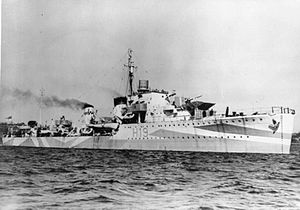 HMS Harvester after 1942 conversion to escort destroyer
| |
| History | |
|---|---|
| Name | Jurua |
| Ordered | 6 December 1937 |
| Builder | Vickers-Armstrongs, Barrow-in-Furness |
| Laid down | 3 June 1938 |
| Fate | Purchased by the United Kingdom, 5 September 1939 |
| Name | HMS Handy |
| Launched | 29 September 1939 |
| Acquired | 5 September 1939 |
| Commissioned | 23 May 1940 |
| Renamed | HMS Harvester, January 1940 |
| Identification | Pennant number: H19[1] |
| Fate | Sunk by U-432, 11 March 1943 |
| General characteristics (as built) | |
| Class and type | Brazilian H-class destroyer |
| Displacement | |
| Length | 323 ft (98.5 m) |
| Beam | 33 ft (10.1 m) |
| Draught | 12 ft 5 in (3.8 m) |
| Installed power | 34,000 shp (25,000 kW) |
| Propulsion |
|
| Speed | 36 knots (67 km/h; 41 mph) |
| Range | 5,530 nmi (10,240 km; 6,360 mi) at 15 knots (28 km/h; 17 mph) |
| Complement | 145 |
| Sensors and processing systems | ASDIC |
| Armament |
|
HMS Harvester was an H-class destroyer originally ordered by the Brazilian Navy with the name Jurua in the late 1930s, but bought by the Royal Navy after the beginning of World War II in September 1939. Almost immediately after being commissioned, in May 1940, the ship began evacuating Allied troops from Dunkirk and other locations in France. Afterwards she was assigned to the Western Approaches Command for convoy escort duties. Harvester and another destroyer sank a German submarine in October. She was briefly assigned to Force H in May 1941, but her anti-aircraft armament was deemed too weak and she was transferred to the Newfoundland Escort Force in June 1941 for escort duties in the North Atlantic. The ship was returned to the Western Approaches Command in October 1941 and was converted to an escort destroyer in early 1942. Harvester was torpedoed and sunk in March 1943 by a German submarine after having rammed and sunk another submarine the previous day while escorting Convoy HX 228.
- ^ Whitley, p. 112